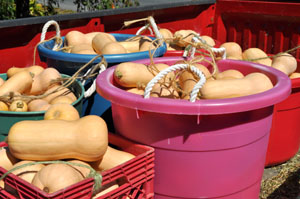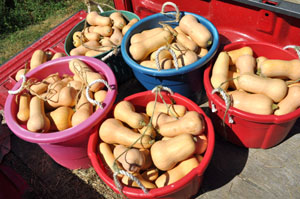Posted by · 2 Comments
Let’s do a little math. We ordered a quarter-pound packet of Waltham butternut seeds, knowing that would more than cover us for planting in the spring (we had some seed left from last year) and ended up planting only half that amount. The packet was $8.95.

 We are in the midst of harvesting the butternuts now. This load is the first picking and represents about 500 pounds. Altogether? We’ll get about 1500 pounds of butternut squash out of the less-than-half packet of seed that was planted.
We are in the midst of harvesting the butternuts now. This load is the first picking and represents about 500 pounds. Altogether? We’ll get about 1500 pounds of butternut squash out of the less-than-half packet of seed that was planted.
The Waltham variety is an extremely popular variety — not only with us but with the pollinators. (Remember the blog entry about the bees buzzing in the blossoms?) Its flavor is delicious, it keeps well (we’ll store ours through the winter in our basement, which stays cool and dry), and the plants are consistent and reliable.
So, it’s inexpensive + proven + tasty + reliable + bountiful = A winner!



We have been able to store butternut squash from September all the way to August of the following year by keeping them in a cool dry place. In the winter we place them in a special spot in our attic then we move them into a cool place in the garage in the spring because the attic gets really hot on sunny spring days. We are able to eat butternut squash all year until the next harvest. Butternuts and Pumpkins must be cured in the sun for at least ten days before winter storage and must never be allowed to experience full frost. We place a huge tarp over them at night and then uncover them on sunny days. This usually keeps them from freezing and then thawing out later which leads to spoilage. We can only get our large pumpkins to last until about March and a few may last until early April but the butternuts (when properly cured and stored) can last a full year. We have found that butternut squash is the best winter squash for the homestead.
We have a large farm and a smaller backyard garden that gets only about three full hours of sun during the middle of the day. I tried another variety of winter squash this year that did not do well in that shaded area but I allowed a squash plant to grow up that must have been in my compost bedding from what I fed the chickens during the winter and it turned out to be a butternut squash. We only harvested one buttercup squash from about eight plants but the single butternut squash gave us four giant brown butternut squash so far that are about ready for harvest and another four green butternut squash are still growing rapidly (September 18th). The butternut variety does great without full sun and they love chicken manure with the composted bedding. I also added wood ash to the mix and tilled it in. I think that combination produced the biggest butternut squash we have ever grown. Next year we plan on planting a whole lot more butternuts.